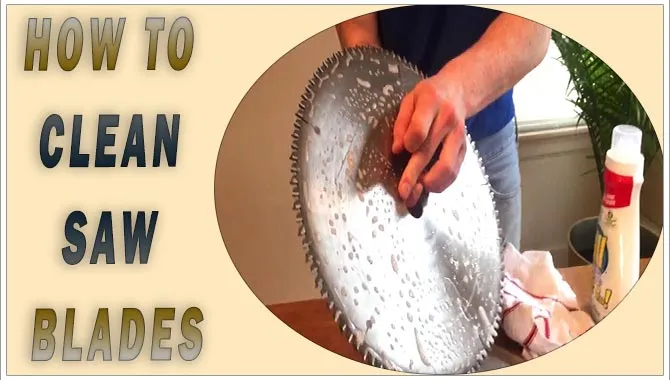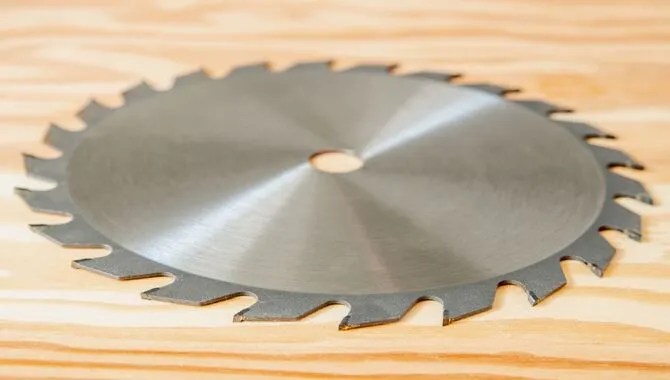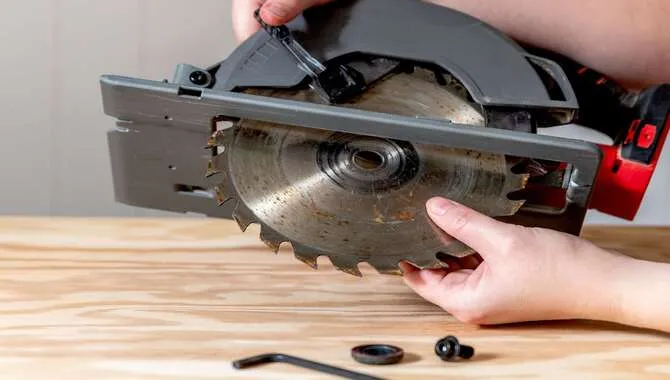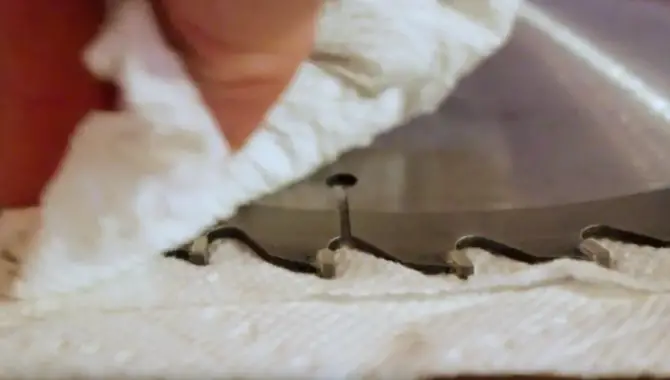Clean saw blades are an important part of ensuring that they are in good condition and will last a long time. Saw blades are some of the most used tools in the construction world.
We can use it for cutting wood, metal, and other materials for construction or woodworking projects. Saw blades come with teeth that allow them to cut through different materials. These teeth can get dirty over time, affecting their performance and reducing the saw’s overall lifespan.
Therefore, cleaning saw blades is essential to keep their performance at its best and ensure maximum effectiveness every time we can use We’ll cover cleaning saw blades and how to do it properly. We’ll also tell you about the best ways to clean saw blades we’ve thought of, and the ideal saw blade lubricants.

What Should I Clean My Saw Blade With?

When cleaning your saw blade, you can follow a few simple steps to ensure the blade is in good working condition and safe to use. It’s important to clean the blade after every use, especially if it’s been dirty or dusty. This helps keep the blade free from buildup that could affect its performance and increase the risk of accidents. You can use a sharp object, such as a household cleaner or brush, to clean the blade.
Depending on the severity of the buildup, you should repeat this step several times. After cleaning the blade, it’s important to rinse it thoroughly and then dry it completely before using it again. With these simple steps, you can keep your saw blade in good working condition and ensure its safety.
The Best 6 Ways How To Clean Saw Blades

There are a few different ways to clean saw blades, but the most effective approach is usually to use a combination of methods. You can use a solvent such as acetone, denatured alcohol, or hot water and soap. It’s important to avoid using harsh chemicals, as they could damage the blade and dull it over time.
You can scrub the blade with the brush to remove Rust or buildup. You can use rinsing water to clean the blade thoroughly and dry it off. Cleaning your saw blade is essential if you want it to last long. Here are six simple steps that will help you get the job done right:
1.Choose Your Cleaning Solution

There are a few different ways to clean saw blades: with water, with soap and water, or with a blade-cleaning solution. Water and soap and water are the most common methods for cleaning saw blades. You place the saw blade in a sink full of warm water and use soap to lather it up.
Then rinse it off with cool water. Blade-cleaning solutions are also popular for cleaning saw blades. These solutions contain detergent, oil, and lubricant, which help to dissolve the dirt and grease on the blade. You should apply the solution to the blade using a cloth or a paper towel, then scrub it off with a hard brush. Be sure to rinse it off completely before storing it away.
2.Let The Blade Soak

Clean saw blades by letting them soak in water and dish soap. Pour enough solution into a bucket to cover the blade, and add enough hot water to make the blade comfortably submerged. Soak the blade for at least 30 minutes or up to eight hours. Rinse it with clean water and dry it off.
When it comes to cleaning saw blades, soaking them in water is the best approach. This will loosen any dirt, dust, or debris that’s obstructing the blade’s ability to cut properly. After soaking the blade for a few minutes, use a mild detergent to clean it off. Make sure to rinse it thoroughly before putting it back into service.
3.Rinse Off The Cleaner
To clean a saw blade, rinse it off with cool water and use a degreaser to remove any dirt, dust, or residue. Be sure to dry it off before putting it back on the saw. Before you can start cleaning, you need to clean the saw blade. To do this, rinse it off with water.
Use a dedicated saw blade cleaner if you have one, or use plain water. Do not use solvents or other harsh chemicals – this will damage the blade and void your warranty. To clean saw blades, rinse them off with water and a good quality cleaner. Make sure to use enough cleaner to cover the entire blade. Use a cloth or a piece of paper to scrub the blade until it is cleaned gently.
4.Dry The Blade
To clean a saw blade, first, dry it off. You can do this by placing the blade on a towel so that the towel covers the entire blade. Please ensure the blade is oriented in the same direction as the teeth on the saw, and hold it in place while you turn it by hand. Repeat this process until the blade is completely dry.
The best way to clean a saw blade is to dry it off. This will prevent the accumulation of dirt, dust, and other debris on the blade, which can cause problems down the line. To dry the blade, hold it at a 90-degree angle and blow air over it from all directions for about two minutes. Be sure to use a filter if you have one.
Clean the blade by suspending it from a dowel or rod and then wiping it down with a cloth. Remove any dirt, Rust, or other substances on the blade. Ensure that the entire blade is covered with the towel, and then place another towel on top to hold in the moisture. Leave the blade like this for at least an hour or two until it’s completely dry.
5.Apply Rust Inhibitor
To keep your saw blades clean and rust-free, apply a rust inhibitor every time you use your saw. This will help protect the metal from rusting and forming fuzziest, making it hard to cut correctly. Many types of rust inhibitors are available on the market, so it’s important to find one specifically designed for saw blades. Some popular rust inhibitors include saltpeter, sulfur, amine, and hydrazine.
It’s important to apply the inhibitor every time you use your saw, even if you don’t see any signs of corrosion. This is because Rust does not discriminate – it will attack any unprotected part of the blade. By regularly applying the inhibitor, you’ll ensure that your blades stay in good condition and that they’re capable of cutting accurately and smoothly.
6.Apply Blade Lubricant (Optional)
Cleaning saw blades is essential to keep them functioning at their best. If you don’t clean them properly, the built-up dust and debris will eventually clog the blade’s cutting edge, causing it to jam. In addition, the oil used to lubricate the blade will also be rendered ineffective and have to be replaced more often.
There are several ways to clean your saw blades: soap and water or blade lubricant. Although both methods work fine, using blade lubricant is usually a better option because it helps prolong the life of your saw blades while minimizing the amount of waste that needs to be disposed of.
To use blade lubricant, add a few drops to your palm and rub it into the blades until they’re completely covered. Make sure you apply enough so that it’s evenly distributed throughout the entire surface of the blade; too much lubricant will make it difficult for the blade to move smoothly. Once you’ve applied it, give your saw a few minutes to start working properly before moving on to the next stage of building your project.
How To Clean Saw Blades With Water

If you’re using a saw to cut something, it’s important to clean the blades regularly so that the saw doesn’t get clogged up with pieces of wood. To clean the blades, unplug the saw and remove the blade. Then, pour water into the reservoir at the back of the saw and turn it on until it’s hot.
Quickly place the blade in the water and wait thirty minutes before removing it. Do not put too much pressure on the blade when cleaning it – try to move it gently with your fingers. Dry off the blade with a cloth and store it safely.
Cleaning Different Types Of Blades
There are a few different ways to clean saw blades, but the most common is to use a blade cleaner. Blade cleaners work by dissolving the blade’s dirt and debris, which you can easily rinse off. Another popular way to clean saw blades is with water and a soft cloth.
Wet the cloth and wring it out well before wiping it down the blade. Be sure to avoid getting any liquid on your skin or clothes, as this can lead to skin irritation or injury. You can also use a wire brush to clean saw blades. This is especially effective if any built-up clogs or deposits on the blade need to be removed. Just insert the wire brush into the water and scrub until everything is gone.
How To Clean Saw Blades With A Blade Lubricant

Cleaning saw blades with a blade lubricant is important in keeping them in good condition. Not only will this prevent them from rusting and breaking, but it will also make them more resistant to sticking and jamming. There are a few different blade lubricants available on the market, so it’s important to find one that corresponds to the type of saw you’re using.
Some lubricants are designed for woodworking tools, while others are specifically for saws. It’s best to test out a few different brands before you decide on the one that works best for you. To clean your saw blades, apply the lubricant to the blade by rubbing it into the surface. Then scrub the blade using a circular motion with a brush or rag. Rinse off the blade under running water.
Conclusion
There are a few ways that you can clean saw blades. The most important thing is to ensure that you keep them clean and free from debris so they can operate at their best.
To clean saw blades, you will need to remove the material stuck to them and then use a blade cleaner or solvent to clean them. Make sure to use a mild solution and avoid harsh chemicals, as they could damage the blade. There is no denying that saw blades get dirty and build up a lot of dust and wood particles.
And, yes, these can cause Rust and decrease saw blade sharpness, which could lead to cutting inaccuracies and wood-splitting mishaps. While cleaning saw blades could be time-consuming, the right cleaning solution, cleaning solution, and how to brush and scrub saw blades can help you get cleaner saw blades in no time.
Frequently Asked Questions
Will Vinegar Clean Saw Blades?
Yes, vinegar can clean saw blades. Vinegar is a natural and effective way to clean any type of metal, including saw blades. Put a small amount of vinegar on a cloth and wipe down the blades. Allow the blade to dry completely before using it again.
How Do You Clean Resin From A Saw Blade?
Before you can start cleaning the resin off a saw blade, you first need to neutralize the acid drawn up by the resin. To do this, you’ll need to mix some sulfuric acid with water and pour it over the blade. Then, please wait until the mixture has absorbed into the resin, and then use a cloth to clean it off.
What Type Of Brushes Should I Use For Cleaning My Saw Blades?
You can use a few different types of brushes to clean your saw blades. The most important thing is to choose the brush appropriate for the type of dirt or debris you’re trying to remove. To clean small saw blades, you can use a bristle brush. This brush is designed to easily move dust and small particles around the blade. For larger saw blades, you’ll need to use a wire brush. This brush has stiff bristles that help it scrub away built-up dirt and debris from the blade.
What Is The Best Way To Wash My Saw Blades?
There are a few different ways to clean saw blades, but the best way to determine which works best for you is to try them all out and see what works the best. The method that many people use is using an enzyme-based cleaner. This type of cleaner detergents the blade with enzymes that break down grease, oil, and other residues. It’s a good choice if you want to keep your blades clean but only have time to wash them sometimes.
What Are The Benefits Of Using A Power Tool For Cutting Wood?
Power tools are great for cutting wood because they allow you to cut through tough materials faster and more easily than with a saw blade. There are several benefits of using a power tool for cutting wood:
They’re easier to use than saw blades.
They’re less likely to cause injury.
They’re more accurate, which is important when cutting straight lines.

I am passionate about tools and electric work. I love finding new tools and experimenting with them.

